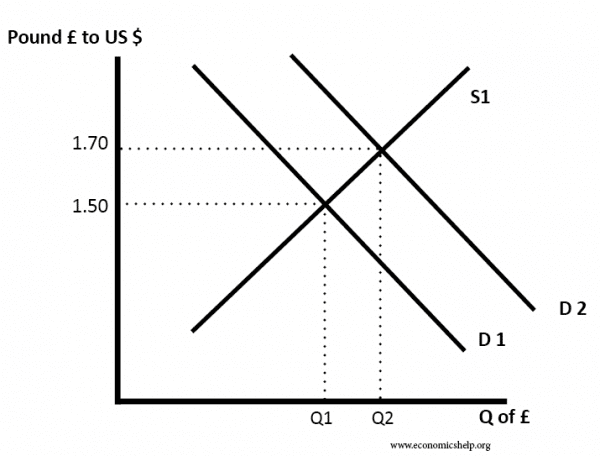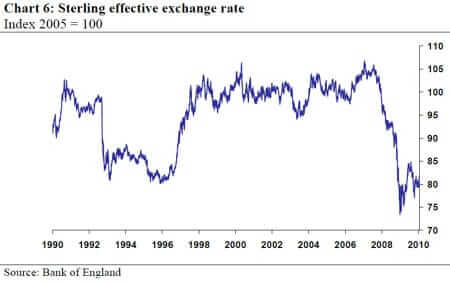Exchange rates are determined by basic supply and demand factors. The demand for a currency is influenced by factors, such as interest rates, economic growth and inflation.
For example, if there was greater demand for American goods then there would tend to be an appreciation (increase in value) of the dollar. If markets were worried about the future of the US economy, they would tend to sell dollars, leading to a fall in the value of the dollar.
Determination of exchange rates using supply and demand diagram

In this example, a rise in demand for Pound Sterling has led to an increase in the value of the £ to $ – from £1 = $1.50 to £1 = $1.70
Note:
- Appreciation = increase in value of exchange rate
- Depreciation / devaluation = decrease in value of exchange rate.
Contents
Factors that influence exchange rates
1. Inflation
If inflation in the UK is relatively lower than elsewhere, then UK exports will become more competitive and there will be an increase in demand for Pound Sterling to buy UK goods. Also foreign goods will be less competitive and so UK citizens will buy less imports.
- Therefore countries with lower inflation rates tend to see an appreciation in the value of their currency.
2. Interest Rates
If UK interest rates rise relative to elsewhere, it will become more attractive to deposit money in the UK. You will get a better rate of return from saving in UK banks, Therefore demand for Sterling will rise. This is known as “hot money flows” and is an important short run factor in determining the value of a currency.
- Higher interest rates cause an appreciation.
3. Speculation
If speculators believe the sterling will rise in the future, they will demand more now to be able to make a profit. This increase in demand will cause the value to rise. Therefore movements in the exchange rate do not always reflect economic fundamentals, but are often driven by the sentiments of the financial markets. For example, if markets see news which makes an interest rate increase more likely, the value of the pound will probably rise in anticipation.
4. Change in competitiveness
If British goods become more attractive and competitive this will also cause the value of the exchange rate to rise. This is important for determining the long run value of the Pound. This is similar factor to low inflation.
5. Relative strength of other currencies
In 2010 and 2011, the value of the Japanese Yen and Swiss Franc rose because markets were worried about all the other major economies – US and EU. Therefore, despite low interest rates and low growth in Japan, the Yen kept appreciating.
6. Balance of payments
A deficit on the current account means that the value of imports (of goods and services) is greater than the value of exports. If this is financed by a surplus on the financial / capital account then this is OK. But a country who struggles to attract enough capital inflows to finance a current account deficit, will see a depreciation in the currency. (For example current account deficit in US of 7% of GDP was one reason for depreciation of dollar in 2006-07)
7. Government debt
Under some circumstances, the value of government debt can influence the exchange rate. If markets fear a government may default on its debt, then investors will sell their bonds causing a fall in the value of the exchange rate. For example, Iceland debt problems in 2008, caused a rapid fall in the value of the Icelandic currency.
For example, if markets feared the US would default on its debt, foreign investors would sell their holdings of US bonds. This would cause a fall in the value of the dollar.
8. Government Intervention
Some governments attempt to influence the value of their currency. For example, China has sought to keep its currency undervalued to make Chinese exports more competitive. They can do this by buying US dollar assets which increases the value of the US dollar to Chinese Yuan.
9. Economic growth / recession
A recession may cause a depreciation in the exchange rate because during a recession interest rates usually fall. However, there is no hard and fast rule. It depends on several factors.
Example fall in value of Sterling 2007 – Jan 2009

During this period, the value of Sterling fell over 20%. This was due to:
- Restoring UK’s lost competitiveness. UK had large current account deficit in 2007
- Bank of England cut interest rates to 0.5% in 2008.
- Recession hit UK economy hard. Markets expected interest rates in UK to stay low for a considerable time.
- Bank of England pursued quantitative easing (increasing money supply). This raised prospect of future inflation, making UK bonds less attractive.
Sterling effective exchange rate

Ready to learn more? Check out this article on forex market news and data.
